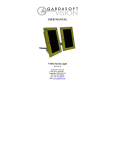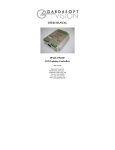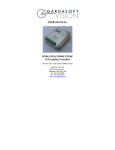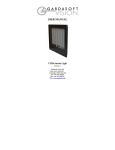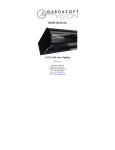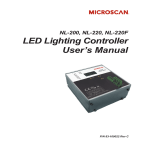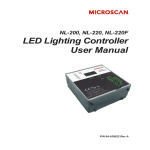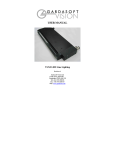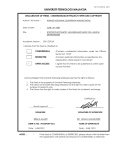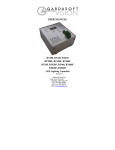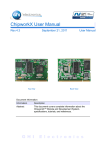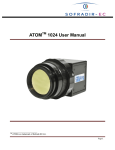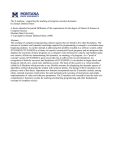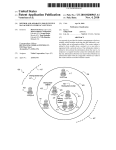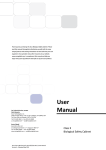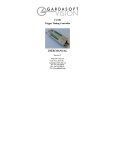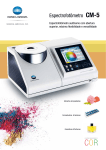Download USER MANUAL
Transcript
USER MANUAL VTR2 Strobe Light Revision 2k Gardasoft Vision Ltd Castle Acres, Elsworth Cambridge, CB23 4JQ. UK Tel: +44 1954 200343 Fax: +44 1954 204343 Web: www.gardasoft.com 2 1 Disclaimer Except as prohibited by law: All hardware, software and documentation is provided on an “as is” basis. This information is for guidance only. Installers must perform their own risk assessment specific to each installation. It is essential that the user ensures that the operation of the product is suitable for their application. The user must ensure that incorrect functioning of this equipment cannot cause any dangerous situation or significant financial loss to occur. Deliberate acts of endangerment and vandalism are not covered by this document and must be considered by the installer. While care has been taken in the preparation of this document Gardasoft Vision Ltd and Gardasoft Products Ltd will not accept any liability for consequential loss of any kind except those required by law. All trademarks acknowledged. Hardware, software and documentation are Copyright 2002 – 2010 Gardasoft Products Ltd. Hardware manufactured by Gardasoft Vision Ltd under licence. 3 2 Getting Started Read the sections on Safety (Sections 3 and 4) and Specifications (Appendix A) and check the VTR2 fulfils your requirements. See the back cover for other Gardasoft Vision strobe lights. Mount the VTR2 as described in Section 4. Connect the VTR2 up to a supply as described in Connections (Section 5). Set up the VTR2 for the desired operation as described in Configuration Commands (Section 9). Visit www.gardasoft.com for application notes on this product. There is also a Support page which has information on troubleshooting problems. 2.1 Summary of Features Throughout this manual, references to the VTR2 refer to all variants in the VTR2 range unless otherwise stated. The convention for the part number is: VTR2-www-aa-ccc where: www aa ccc -T06 -T07 Wavelength of light in nanometres: 740, 850, 940, WHITE Beam angle in degrees: 12 or 30 Communications: ETH, RS232, RS422 Optional suffix for trigger input option Optional suffix for trigger output option 4 3 Safety Read this before using the VTR2. Always observe the following safety precautions. If in doubt, contact your distributor or Gardasoft Vision. The following symbols mean: Warning: read instructions to understand possible hazard Warning: Possible hazardous voltage Warning. Surface may get hot Where these symbols appear in the manual, refer to the text for precautions to be taken. 3.1 Heat The VTR2 can dissipate up to 40W and so can get hot. It should be positioned where personnel cannot accidentally touch it and away from flammable materials. Read the Mounting (Section 4). Do not exceed the power ratings given in the manual. Note that at the maximum ratings the case temperature can reach 65oC. 3.2 Electrical The internal circuit exceeds 46.7V but should not exceed 60V. Pulse peak voltages above 46.7V are considered hazardous. Do not have the cover removed with the power on. Do not open the cover within 1 minute of turning the power off. The VTR2 does not have complete tracking isolation of inputs and outputs. 3.3 General The VTR2 must not be used in an application where its failure could cause a danger to personal health or damage to other equipment. If the equipment is used in a manner not specified by the manufacturer, the protection provided by the equipment may be impaired. 5 4 VTR2 Safety Guidance This guidance below applies to a single VTR2 light. For VTR2 lights with a beam angle wider than 12 degrees, the power density will be less so again the recommended hazard distance above is a safe assumption. High levels of artificial optical radiation can cause damage to both eyes and skin. Exposure limit values have been drawn up for such hazards. Every light system is placed within a Risk Group, which defines the level of risk when the light is used normally. When the light emits less than the exposure limit values it is categorized as exempt. As the VTR2 light systems exceed exposure limits at certain distances and illuminate their targets intentionally for a short time they are placed in Risk Group 1. The hazard distance is the point furthest from the light at which the exposure limit is exceeded. Generally the hazard distance becomes smaller either as the light power output decreases or the less time one is exposed to the light. When used to illuminate targets for speed cameras, the risk assessment has taken into account the position of drivers and pedestrians and the likely times that they may be within the light beam. This includes abnormal situation such as cars queuing for long periods due to traffic conditions For IR models the light output is not visible and thus the aversion response does not automatically protect the eye. These models are all classified as Risk Group 1, when the guidance given here is followed. The primary radiation hazard is the corneal/lens infrared hazard between 720 and 960nm. When installed as detailed below there is no risk to the public. If it is necessary to have the light operating whilst being within 0.5m of the lightface, use appropriate eye protection. Development engineers and field maintenance staff should be given safe procedures for working with the VTR2 light. This guidance assumes that staff working on the light system has been instructed in optical radiation hazards. To allow access to the light within the beam a working distance of 0.5m is used as a hazard distance, which allows an exposure time to be calculated. 6 4.1 Safe Distances for Full Power Operation The following table applies for lights running at full power and maximum duty cycle. Product Risk to Hazard Distance (m) Risk Group VTR2-740-12 VTR2-850-12 Drivers and pedestrians 1 1 Drivers and pedestrians TBA TBA VTR2-940-12 VTR2-WHITE-12 VTR2-740-12 VTR2-850-12 VTR2-940-12 VTR2-WHITE-12 Maintenance staff 0.5 1 Maintenance staff TBA TBA Comments No exposure time limit. Ensure that light is mounted at a height such that distance L always exceeds the hazard distance (HD) Maximum exposure time 5 minutes or wear eye protection prior to entering beam. Safe Power for Short Distances Product Risk to Downrating for a member of the public at 0.1m from the light Downrating for a member of the public at 0.2m from the light VTR2-740-12 Drivers and pedestrians 25% 30% VTR2-850-12 Drivers and pedestrians 15% 20% VTR2-940-12 Drivers and pedestrians 35% 40% VTR2-WHITE-12 Drivers and pedestrians TBA TBA 7 Downrating is the amount that the light must be reduced from full power to make it safe. For example when full power is 100% intensity at 2% duty cycle, 25% downrating would be: 25% intensity at 2% duty cycle, or 100% intensity at 0.5% duty cycle. In both cases the radiated power is 25% of full power. 4.2 Product Labelling The IR versions of this product are labelled: Risk Group 1 WARNING IR emitted from this product 4.3 Disclaimer This information is for guidance only. Installers must perform their own risk assessment specific to each installation. While Gardasoft Vision has taken every care in the preparation of this advice, Gardasoft Vision and Gardasoft Products accept no liability for damages of any kind, except those required by law. Deliberate acts of endangerment and vandalism are not covered by this document and must be considered by the installer. 8 5 5.1 Mounting Heatsinking The approximate heat dissipation of the VTR2 can be calculated as follows: HD = 18 * BR * PW * TF + 2 Where: HD Heat dissipation (W) PW Strobe pulse width (seconds) TF Maximum trigger frequency (Hz) BR Brightness of the light output (%) Without any heatsinking the internal temperature of the VTR2 will rise TBA oc per watt of heat dissipation. Given the range of ambient temperatures and radiated sunlight, the installation must provide enough heatsinking on the rear surface to keep the internal temperature of the VTR2 below 70oc. 9 6 Connections See the Specification (Appendix A) for information on connection ratings. Assembled cables are available from Gardasoft Vision to the customer’s specification. All connections are provided on a 14 core cable. The wire allocation varies depending on the options provided. Wire Colour ETH option RS232 option Blue Black POWER − POWER − POWER + POWER + White TRGI − TRGI − Brown TRGI + TRGI + Grey TX+ GND Pink TX− NO CONNECT Yellow RX+ TXD Green RX− RXD Yellow/White TRGO− TRGO− Yellow/Brown TRGO+ TRGO+ Grey/Pink Red Red/Blue Violet 10 6.1 Power Supply Choose a PSU that limits its output current by design, by setting the current limit on the supply (if this feature exists) or use fuses. Remember to derate the fuse, if mounted in an enclosure, as the temperature will be higher than ambient. The external power supply will need to be able to supply at least 3.2A. The use of a regulated power supply with 100% short circuit protection is recommended. If however a non-regulated power supply is used, then the maximum ripple voltage of this power supply must not exceed 10% of the actual DC value. Route low voltage and mains wiring separately. If they must be loomed together ensure that low voltage insulation rating is sufficient or that supplementary insulation is used. Power supply cable length is recommended not to exceed 3m. If longer cables are fitted, or if surge or transient interference greater than +/-60V may occur on the power supply lines, additional surge protection should be provided. 6.2 Trigger Input Option There is an optional opto-isolated trigger input. The opto-isolator isolates voltages up to 50V. Signal Function TRGI –ve Trigger input –ve. TRGI +ve Trigger input +ve. The trigger input circuit is as follows: The trigger input circuit is as follows: When a voltage of 5V to 24V is applied across TRGI –ve and TRGI +ve, the trigger input is logic 1 (on). When a voltage of 0V to 2V is applied across TRGI –ve and TRGI +ve, the trigger input is logic 0 (off). The trigger input takes about 3mA at all voltages from 5V to 24V. 11 6.3 Trigger Output Option There is an optional trigger output which is opto-isolated. The opto-isolator only isolates voltages up to 50V. Signal Function TRGO –ve Trigger input –ve. TRGO +ve Trigger input +ve. The trigger output circuit is as follows: The trigger output can be used to switch a signal of up to 24V, switching up to 20mA when on. When the output is logic 1 (on) a current of up to 20mA can flow. The max current must be limited to 50mA by the external circuit. The forward voltage is less than 2V. When the output is logic 0 (off) a voltage of up to 24V can be blocked. 6.3.1 Ethernet Option The Ethernet connection is 10BaseT and runs at 10Mbits per second. 6.3.2 Serial Option The RS232 connections are as follows. The communications port should be set to 115Kbaud, no parity, 8 data bits, 1 stop bit. Connecting to the specified pin on a 9-way female D-type will allow straight through connection to a PC COM port. Signal Function Connection pin on a standard PC 9-way Female D-Type GND Connected to power input –ve 5 RX Receive input to VTR2 3 TX Transmit output from VTR2 2 12 6.3.3 RS422 Option The RS422 connections are as follows. The communications port should be set to 115Kbaud, no parity, 8 data bits, 1 stop bit. Signal Function RX A Receive input, normally high RX B Receive input, normally low TX A Transmit output, normally high TX B Transmit output, normally low 13 7 General Description The VTR2 current controller provides repeatable intensity and timing control for strobe lighting. Two modes of operation are provided for the light output: Pulse (Strobe): In pulse mode output is pulsed once per trigger. One trigger input is used as a trigger. The delay from trigger to pulse, the pulse duration and the brightness can be set. Switched: In switched mode a trigger input can be used to switch the output current on and off. The sense of the trigger signal can be active high or active low. The set up is non-volatile, so the VTR2 will resume the same operation after a power cycle. 7.1.1 Pulse and Duty Cycle Limits In both pulsed and switched modes, the pulse width and duty cycle are internally limited to prevent damage to the light. The brightness can be set up to 100%, but only for short periods and at low duty cycles, so that the lighting does not overheat and get damaged. In pulse mode, the duty cycle is limited by ignoring triggers which are too soon after the previous trigger. Output Brightness Allowed Pulse Width for 850nm and 940nm lights Allowed Duty Cycle for 850nm and 940nm lights Allowed Pulse Width for white and 740nm lights Allowed Duty Cycle for white and 740nm lights 0 to 20% 3ms 6% 3ms 3% 21 to 30% 3ms 6% 2ms 3% 31% to 50% 3ms 3% 2ms 2% 51% to 100% 1ms 2% 1ms 1% So for example, if the brightness is set to 40%, then a VTR2-850 will not allow pulses greater than 3ms long. With 1ms pulses, if a trigger occurs within 33ms of a previous trigger (so that the duty cycle would be greater than 3%) the trigger is ignored. If necessary the VTR2 will limit the duty cycle by increasing the retrigger delay. When the VTR2 internal temperature gets too high, the allowed duty cycle is reduced and event 149 is generated. This typically happens at 50oC. 14 7.1.2 Pulsed Output The output is off by default. When the VTR2 is triggered it will wait for a delay and then pulse the output. Retrigger delay is the minimum allowed time from one trigger to the next. Any triggers that happen too soon after the previous trigger are ignored. The retrigger delay is set in multiples of 100us. The delay, pulse width, retrigger delay and pulse intensity are all configurable. 7.2 Switched Output Switched mode uses the trigger input to switch the output on or off using the timing of the trigger signal. The output brightness can be varied from 0% to 100%. The VTR2 will apply the same duty cycle and pulse width limits as for pulse mode, to prevent the light being damaged. 7.3 Internal Trigger Timer An internal timer is available for continuous triggering in pulse mode. The period of this timer is configurable. Note that the internal timer is mostly used when synchronising a camera using the trigger output. It is generally not possible to run the light strobe from this timer while free running the camera. They will not stay synchronised and the images will have very variable intensity. When this timer is turned on, the light strobe pulse and the trigger output are both triggered by this timer. External triggers still work. When troubleshooting during development, it is sometimes useful to set this timer to give regular light pulses. 7.4 Trigger Input Option An optional trigger input signal is available. The trigger input is used as follows: Mode Trigger Input Output Switched Trigger input = off Output is off if P flag = 1 Output is on if P flag = 0 Trigger input = on Output is on if P flag = 1 Output is off if P flag = 0 15 Pulsed Trigger rising edge Pulse is triggered if P flag = 1 Trigger falling edge Pulse is triggered if P flag = 0 Note that the P flag inverts the sense of the trigger input. 7.5 Trigger Output Option An optional trigger output signal is available. When fitted this signal can be used to trigger a camera. It can be used for pulse width exposure control of the camera. The trigger timing for the light and camera can be adjusted relative to each other. This output is triggered at the same time as the light strobe output. The delay and pulse width for this signal can be controlled independently of the light pulse. 7.6 Factory Settings The default VTR2 configuration for the light output and trigger output are: • • • • • Pulse operation 1ms pulse width 0.01ms delay 50% intensity 30ms retrigger delay The configuration can be cleared to the default settings, by sending the CL command. 16 8 Ethernet Address (Ethernet Version Only) You may need to ask your network administrator for advice about setting up the Ethernet connection. Ethernet set up is not affected by cold booting the VTR2. 8.1 Connection The Ethernet link uses a 10 base-T connection on an RJ45 connector. The VTR2 will usually be connected to a network switch (or hub or router). It is also possible to connect it direct into the network port on a PC by using a crossover cable. 8.2 IP Address The VTR2 needs an IP address to communicate over Ethernet. There are two ways to get an IP address; either programmed into the unit or using DHCP. Most networks use a DHCP server. If there is a PC on the network, You may be able to find out whether a PC on the same network uses DCHP as follows: • Go to Control Panel • Select Network Connections • Right click on Local Area Connection. Select Properties • From the list, select Internet Protocol (TCP/IP), press Properties If “Obtain an IP address automatically” is set, then DHCP is probably used. However, there may be an alternative fixed IP address on the “Alternative Configuration” tab. You can find out what IP address is being used by a PC at any time by: • Go to Control Panel • Select Network Connections • Right click on Local Area Connection. Select Status • Select the Support tab. The IP address is displayed When using a fixed IP address, you must ensure that you use an IP address that is not being used by any other device on the network. It is usual to keep the first three numbers of the IP address the same as other devices and to change only the last number. For example, if you have a network consisting of a PC (IP address 192.168.1.35) and two VTR2s, you might give them addresses 192.168.1.201 and 192.168.1.202. 8.2.1 Programmed IP Address and DHCP For DHCP mode, the VTR2 acquires its IP address, subnet mask and gateway address from a DHCP server. Otherwise the VTR2 has a fixed IP address, subnet mask and gateway address. 17 DHCP mode or the IP address can be set and read the VTR2 Configuration Program available for download at www.gardasoft.com. 8.2.2 Automatic Sensing All the features below are implemented in a Configuration Program with C++ source code available from www.gardasoft.com. The VTR2 will send out a message on three events: • On power up • When an IP address is received or renewed by DHCP • When an enquiry message is received On the first two events, the message is broadcast. On the third it is a reply to a single IP address. An enquiry message is a UDP packet from source port 30310, destination port 30311 with the message body “Gardasoft Search” (8-bit ASCII, 13 characters). The message output by the VTR2 is a UDP packet from source port 30311, destination port 30310. It is formatted as: Gardasoft,VTR2,000000,111111111111,22222222 (8-bit ASCII, 44 characters), where 000000 the serial number of the unit 111111111111 the MAC address in 6 HEX bytes 22222222 the IP address in 4 HEX bytes For example for VTR2 serial number 12345, IP address 192.168.1.103, MAC address 00.0B.75.01.80.99 the packet will contain Gardasoft,VTR2,012345,000B75018099,C0A80167 18 9 Webpage Configuration (Ethernet Version Only) The VTR2 has a webserver inside, so that it can be configured from a standard web browser, such as Internet Explorer. The IP address of the VTR2 must be known (see section 7 on Ethernet Address. Open a web browser window and type the IP address (for example 192.168.1.71) of the VTR2 into the URL box at the top. The main page of the VTR2 webserver should be shown. 9.1 Main Page The main page shows general information about the VTR2. Links are provided to the configuration pages. 9.2 General Setup Page The General Configuration page allows the webpage protection password to be set or cleared and the internal trigger to be set up. Also any Ethernet command from Section 9 can be entered. “Test Mode” referred to on this page is the internal trigger timer. 9.3 Light Configuration Page This page allows the parameters for the light output to be set up. Press the Submit button to update the VTR2 and save the changes to non-volatile memory. Some measured values are displayed on this page. 9.4 Trigger Output Configuration Page This page allows the parameters for the trigger output to be set up. Press the Submit button to update the VTR2 and save the changes to non-volatile memory. 19 10 Configuration Commands The VTR2 can be configured via the Ethernet connection using UDP or TCP/IP. A Configuration Program with source code can be downloaded from www.gardasoft.com. 10.1 Ethernet Communication For TCP, commands from a host should be sent to destination port 30313. Replies will be to destination port 30312. For UDP, commands from a host should be sent from source port 30312 to destination port 30313. Replies will be sent from source port 30313 to destination port 30312. 10.2 RS232 and RS422 Communication When using RS232 or RS422 the COM port should be set to 115200baud, 8 data bits, no parity, 1 stop bit, no handshaking. 10.3 Command Structure Communication consists of commands sent by the host (controlling PC). All output generated by the command is returned in reply UDP or TCP/IP packets. The last character sent is “>” (“greater than” symbol). Once this is received, the host knows that the command has been completed. It is recommended that the host waits for the “>” symbol before sending the next command. UDP communications are not guaranteed to arrive, so the host software must be able to cope with lost messages. Using the GT command, a host can request that a message is sent to it whenever an error occurs. Several commands can be put into one command line by separating them by a semi-colon (“;”). A carriage return character should be sent to terminate the command line. The VTR2 will send any replies to the commands and then send a ‘>’ character to indicate that the command line has been completed. Commands comprise a code of two letters followed by the parameters (if any) needed for the command. Spaces in the commands are ignored. Numeric parameters are separated by a comma (“,”). For a parameter which is a time period the default units are milliseconds. “s”, “ms” or “us” can be added to the end of the number to indicate seconds, milliseconds or microseconds. For example: Parameter Meaning 0.1 0.1 milliseconds 200us 200 microseconds 0.1s 0.1 seconds Note that parameters are in “USA/UK” format so that a half is written “0.5” not “0,5” 20 The command codes and their meaning are described below. The upper case commands are shown, followed by lower case letters denoting the numeric argument. Error number Reason Err 1 A parameter value is invalid Err 2 Command not recognised Err 3 Numeric value is wrong format Err 4 Wrong number of parameters Err 5 (This is only a warning) A timing parameter was out of range and has been adjusted to a valid value. Any changes made using Ethernet commands are not saved permanently until the AW command has been issued. 10.3.1 General Commands Report the version of firmware running in the VTR2 VR This command returns the firmware version. For example: VTR2 (HW001) V001 Set switched mode The output is set to switched mode at a percentage of full brightness. RW1,s Where: s = setting in percent (s = 0 to 100) Set pulse mode The output can be set up to pulse on a trigger input. The delay from trigger to the start of the pulse, the length of the pulse and the brightness are configurable. An error is generated if the brightness setting requires a current greater than 20A or if the combination of pulse width and setting is not allowed. RTc,p,d,s RTc,p,d,s,r Where: c 1 = Light strobe output , 2 = Trigger output signal p = pulse width in milliseconds (0.01 to 3) d = delay from trigger to pulse in milliseconds (0.01 to 999) s = setting in percent (s = 0 to 99) r = retrigger delay in milliseconds. This parameter is optional 21 Set the Option Flags REc,p Where: c p=0 p=4 1 = Light strobe output , 2 = Trigger output signal P flag set (positive triggers) P flag cleared (negative triggers) Set Internal Trigger Enable or disable the internal trigger. When enabled, all outputs are triggered simultaneously using an internal trigger signal. This setting can be saved to non-volatile memory using the AW command. TT0 Disable internal trigger TT1 Enable internal trigger (uses previously set period) TT1,p Enable internal trigger and set the period Where: p= period of the triggers in microseconds For example: TT1,200 TT1,1S Set the internal trigger to 200ms (5Hz) Set the internal trigger to 1 second (1Hz) Save the settings to memory AW The results of the VL, RW, RT, RE, TT, AW commands are all saved. Once the settings are saved to memory they are then retained when the unit is switched off. If this is not done, changes to the settings are volatile, and if the unit is switched off they revert to those in force when the last AW command was issued. Clear Configuration CL Clears the configuration. The results of the VL, RW, RT, RE, TT, AW commands are all cleared. Simulate an Input Trigger TR1 Simulates a trigger pulse. If the channel is in pulse mode it will pulse. Enable Ethernet Messages GTm m = 0 to disable Ethernet messages = 1 to enable Ethernet messages When Ethernet messages are enabled, any error reports are sent to the most recent UDP or TCP address from which a command has been received. Messages are of the form: Evt1,e Where v event value: 22 32 to 47 Lighting error code Clear any Errors GR If Ethernet messages are not enabled, the last event or error number can be read by this command. If there was a lighting error, the VTR2 will resume operation. The reply will be in he same form as the GT command above. If there are no outstanding events or errors, then only the prompt “>” is returned. Set/Clear the Webpage Password EY EY asc1, asc2, asc3, asc4, asc5, asc6 This command sets the password required to access the webpages. If EY is entered on its own then the password is cleared. There are six optional parameters, which are decimal ASCII values for a password from one to six letters. A value of 65 is ‘A’, 66 is ‘B’, etc to 90 is ‘Z’. 10.3.2 Command Summary Command Example Effect AW AW Save changes CL CL Clear configuration GT GT1 Enable Ethernet messages GR GR Clear any error condition. EY EY65,66 Set webpage password to “AB” VR VR Read the firmware version RW RW1,50 Set channel 1 to 50%, switch mode RT RT1,3,100us,50 Set light to strobe with 3ms pulses, delayed by 100us, at 50% brightness RE RE1,4 Trigger on falling edge of trigger input TT TT1,100ms Set internal triggers every 100ms TR TR1 Trigger an output pulse 23 A. Ratings The electrical ratings of the connections are: Signal Rating Power Input 24VDC +/- 10%. Maximum ripple 10%. Other power supply options available. Trigger Input Opto-coupler input: ~1Kohm series R. 0V to 2V is a logic 0. 5 to 24V is a logic 1, drawing between 3.5 and 22.5mA. Trigger Output Opto coupler transistor output: Maximum switched voltage Vceo = 30V Load current should be externally limited to 50mA max. 24 B. Restrictions The following timings and restrictions apply for firmware revision V001. Later firmware versions may have lesser limits. The minimum pulse delay for the light pulse output is about 2us. When using the retrigger delay, the minimum delay is around 5us. For pulse widths less than approximately 70us fault detection does not operate. The minimum delay for the trigger output is about 2us. 25 C. Error Codes Error number Reason Err 1 A parameter value is invalid Err 2 Command not recognised Err 3 Numeric value is wrong format Err 4 Wrong number of parameters Err 5 This is a warning, not an error. One of the parameters is out of range. The value of the parameter has been adjusted. For example, sending an RT command with a delay of 0 will get a reply of “Err 5”. The command will be accepted and the delay set to the minimum allowed. Err 8, 12 EEPROM corrupt. The configuration has been cleared. Err 9, 20 Couldn’t save settings to EEPROM. Err 27 Can’t read Ethernet settings from EEPROM, so these may be incorrect. Err 33 The VTR2 is too hot. The VTR2 has a thermal cutout which operates around 65O c to 70O c, depending on conditions. Err 35 One of the lighting strings has failed. The light will continue to operate but may have slightly reduced brightness. NOT IMPLEMENTED YET Err 36 One of the lighting strings has failed and the light cannot operate. NOT IMPLEMENTED YET Any other errors are internal errors. 26 D. Event Codes Event messages are sent when an error occurs. The format of these is: Evt<channel>,<event code>; These event messages are only sent after the GT1 command has been sent. Event number Reason 1 to 127 An error has occurred. The error code is given by the event number. 130 The temperature of the light is too high and operation has been stopped. 148 The allowed duty cycle is now normal (after event 149). 149 The allowed duty cycle has been reduced due to high internal temperature. 27 Gardasoft LED Lighting Controllers The products available at the time of writing include the following. Other products are also available. See www.gardasoft.com for details of the current range. RT Range • • • • • 2, 4 or 8 output channels up to 20A each 2, 4 or 8 trigger inputs SafePower TM and SafeSenseTM Front panel, RS232 or Ethernet configuration Fast pulsing option RT200-20 RT220-20 RT260-20 RT200F-20 RT220F-20 RT260F-20 RT420-20 RT420F-20 RT820F-20 RT860F-20 Lighting controller: 2 channels up to 20A pulsing, front panel Lighting controller: 2 channels up to 20A pulsing, Ethernet Lighting controller: 2 channels up to 20A pulsing, RS232 Lighting controller: 2 channels up to 20A fast pulsing, front panel Lighting controller: 2 channels up to 20A fast pulsing, Ethernet Lighting controller: 2 channels up to 20A fast pulsing, RS232 Lighting controller: 4 channels up to 20A pulsing, Ethernet Lighting controller: 4 channels up to 20A fast pulsing, Ethernet Lighting controller: 8 channels up to 20A fast pulsing, Ethernet Lighting controller: 8 channels up to 20A fast pulsing, RS232 PP704 DIN Rail mounting clip for RT range PP Range • • • • • 2, 4 or 8 output channels up to 20A each 2, 4 or 8 trigger inputs SafeSenseTM option Front panel, RS232 or Ethernet configuration Fast pulsing option The PP range will continue to be available for many years. Machine Vision Timing Controller CC320 Controller • • • • • • 8 digital inputs 8 digital outputs 1 or 2 wire Encoder input Very flexible operation Ethernet control Front panel configuration PP703 DIN Rail mounting clip for CC320 28 Gardasoft Traffic Strobe Lights The products available at the time of writing include the following. Other products are also available. See www.gardasoft.com for details of the current range. VTR1 Range • • • • • Up to 300W per steradian output power Infra red 740nm, 850nm, 940nm and white options Ethernet and RS232 options Trigger input and trigger output options 12 degree and 30 degree beam angle options VTR2 Range • • • • • Up to 3000W per steradian output power Infra red 740nm, 850nm, 940nm and white options Ethernet, RS232 and RS422 options Trigger input and trigger output options 12 degree and 30 degree beam angle options




























